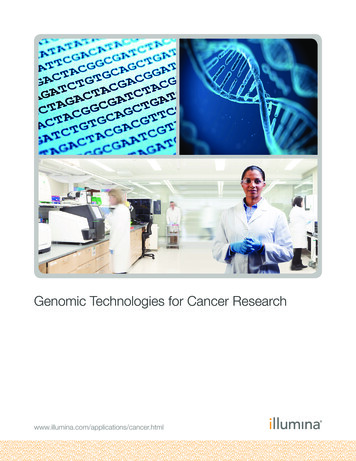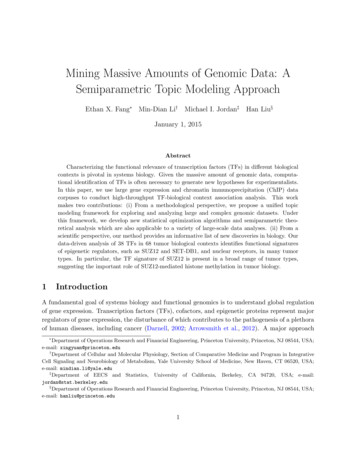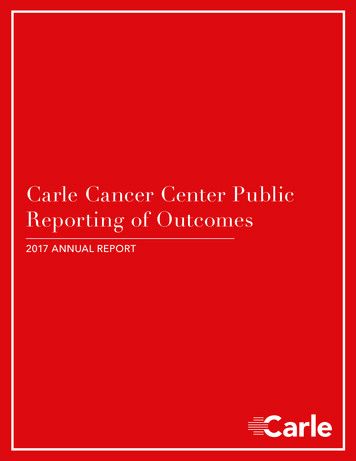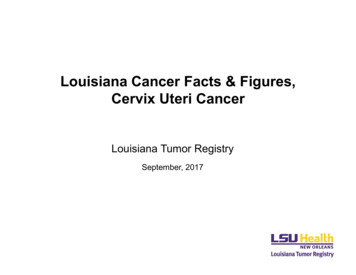
Transcription
Genomic Technologies for Cancer Researchwww.illumina.com/applications/cancer.html
Table of ContentsI. Introduction: Genomic Technologies for Cancer Research3II. Approaches for Detecting Somatic Mutations4Targeted Sequencing Solutions for Somatic Mutation Detection4Exome Sequencing4Focused Sequencing Panels4Custom Targeted Sequencing4Whole-Genome Sequencing Solutions4Data Analysis Tools for Somatic Variant Detection5III. Evaluating Germline Mutations in Cancer6Targeted Sequencing to Detect Common Germline Mutations7Microarray-Based Approaches7IV. Structural Variant Detection in Cancer7DNA and RNA Sequencing for Translocation Detection8Copy Number Variation Arrays8V. Investigating Gene Regulation in Cancer8DNA-Protein Interactions8DNA Methylation9RNA Sequencing9Targeted RNA Sequencing9Small RNA Sequencing10Data Analysis Tools for the Study of Gene Regulation11VI. Summary11For Research Use Only. Not for use in diagnostic procedures.
I. Introduction: Genomic Technologies for Cancer ResearchHETEROGENEITYPROGRESSIONIn recent years, genomic technologies have emerged as invaluable tools in cancer research. International projects suchas the International Cancer Genome Consortium (ICGC)1 and The Cancer Genome Atlas (TCGA)2, tasked with mappingthe biology of dozens of tumor types, would not have been possible without these tools. Next-generation sequencing(NGS) and high-density microarrays are used to study the biology of cancer. Both provide the cancer researchcommunity with a growing body of knowledge that may lead to more effective drug design, better patient treatmentoptions, and more accurate prognoses.3NormalNeoplastic ChangesTumorResponseRecurrenceSomatic MutationsGermlineMutationsGene Expression &Epigenetic ChangesSomatic MutationsChromosomal AbnormalitiesFigure 1: The Tumor Progression Pathway—Genomic technologies are helping researchers achieve a deeper understanding of the tumorprogression pathway. Much of the research thus far has focused on the study of basic tumor biology and the identification of variants in germlineDNA that influence cancer risk and susceptibility. However, there has been a shift over the past few years to more translational study designs,linking genetic information with clinical phenotypes to understand the clinical significance.NGS is particularly suited to the study of cancer biology. Key applications include: Paired tumor-normal (T/N) whole-genome sequencing (WGS) or T/N whole-exome sequencing (WES)have emerged as ideal methods for the discovery of somatic mutations. NGS-based RNA sequencing (RNA-Seq) has revolutionized gene expression studies by enablingresearchers to measure relative expression changes across the whole genome in a single experimentand to identify novel transcripts. RNA-Seq has also emerged as a leading method for identifying gene fusions—a critical class of somaticdriver mutations in tumor cells. Chromatin immunoprecipitation sequencing (ChIP-Seq), bisulfite sequencing, or methylation-targetingmicroarrays, can be used to investigate the role of epigenetic factors in the biology of tumorigenesis.The adoption of these genomic approaches in cancer research has led to a deeper understanding of tumor biologyand is establishing the foundation necessary to support the long-term goals of personalized medicine. Researchersare also using NGS and microarray-based genotyping of germline DNA to identify inherited variations that influencecancer susceptibility. While NGS is an excellent tool for assessing the germline status of known cancer predispositiongenes and identifying novel loci, microarrays are ideal for large-scale population studies, where large sample numbersare required to identify weakly predisposing genes.4This primer describes the broad portfolio of genomic technologies offered by Illumina that are directly applicable tocancer research.For Research Use Only. Not for use in diagnostic procedures.–3–
II. Approaches for Detecting Somatic MutationsDepending on the experimental goals, desired throughput, and available budget, researchers can choose acomprehensive, whole-genome approach or a focused, targeted approach to somatic variant detection (Table 1).Whole-genome sequencing offers a hypothesis-free method for the discovery of somatic changes across the genome,while targeted sequencing allows researchers to focus their investigation on specific regions of interest based on a prioricriteria. For a given budget, targeted sequencing enables higher coverage across specific regions of interest, enablingthe detection of low frequency subclones within heterogeneous tumors or detection of rare somatic variants.Targeted Sequencing Solutions for Somatic Mutation DetectionTargeted sequencing offers several key advantages: Significantly narrows the scope of a sequencing projectReduces the overall data analysis burdenLowers the cost of sequencing per sample compared to whole-genome approachesReduces the turnaround time compared to broader applicationsThese advantages also enable researchers to perform deep sequencing, which is critical for identification of raremutations or subclonal detection in heterogenous tumor samples. The trade-off with targeted sequencing is thatit can miss key mutations, such as those found in intergenic or previously unknown regions. Therefore, choosingbetween the comprehensive view offered by WGS or the focused power of targeted sequencing depends on thespecific research goals and available resources.Exome SequencingMany oncogenic variants are found within exons (protein coding regions), which comprise approximately 1% ofthe genome.5 Exome sequencing offers a cost effective, efficient approach for the analysis of T/N cohorts. T/Nexome sequencing has been the preferred method for large projects, such as TCGA, because it offers an attractivecombination of turnaround time and price and because it focuses on the easiest-to-interpret genomic regions.Focused Sequencing PanelsFocused cancer panels are predesigned targeted sequencing panels with content selected by leading oncologyexperts and offer high levels of sensitivity for low frequency somatic variants. Illumina offers focused panels using2 different chemistries to select and sequence-specific content: Amplicon-based targeted sequencing involves a preliminary amplification step using predesigned primermixtures that target specific regions of interest. The amplified targets are then purified and sequenced. Target-capture involves a preliminary DNA capture or enrichment step using predesigned capture probesconjugated to magnetic beads.Illumina focused sequencing panels are compatible with various tissue types including, solid, or liquid tumorsamples, and fresh-frozen or FFPE tissue.Custom Targeted SequencingFor researchers or consortia interested in designing their own targeted sequencing panel, probe design softwareand custom targeted sequencing kits are available for both amplicon-based and target-capture approaches. Bothcustom capture probes or custom amplicon primers can be designed and ordered through Illumina DesignStudio .For more on DesignStudio, visit www.illumina.com/designstudio.For Research Use Only. Not for use in diagnostic procedures.–4–
Whole-Genome Sequencing SolutionsThrough WGS, researchers can compare T/N sample pairs to identify somatic mutations in coding and noncodingregions across the entire genome. This approach is hypothesis-free and is best suited for the discovery of noveldriver mutations.For researchers who prefer a T/N WGS service, the Illumina Genome Network (IGN) Cancer Analysis Serviceperforms medium to large cohort T/N sequencing studies for researchers looking for a cost-effective solution.To learn more about IGN Cancer Analysis Services, visit www.illumina.com/ign.Data Analysis Tools for Somatic Variant DetectionWhether performing whole-genome, exome, or targeted sequencing, Illumina offers seamless workflow solutionsthat include everything from library preparation kits and sequencing platforms, to final data analysis softwarepackages (Figure 2).Figure 2: Illumina Seamless Workflow Solutions—Illumina sequencing solutions are fully integrated, DNA-to-Data solutions from librarypreparation to final data analysis. Prepare T/N paired libraries with optimized kits for WGS, exome, transcriptome, or targeted sequencing.Perform sequencing using the MiniSeq , MiSeq , NextSeq , or HiSeq sequencing systems. Access Illumina data analysis tools for alignment,variant calling, T/N comparative analysis, or expression profiling.Data analysis, the final step in the workflow, is essential to experimental success and must be tailored to theresearch question at hand. For example, it is important that the variant calling method properly model the complexitiesof multiple cancer subclones versus normal sample contamination. Illumina primary data analysis and somatic variantdetection software solutions are easily accessible through on-instrument analysis software, such as MiSeq ReporterSoftware, or through the BaseSpace , the Illumina cloud-based genomic computing environment. Data are streamedfrom the MiniSeq, MiSeq, NextSeq, or HiSeq Systems directly and seamlessly into BaseSpace, which offers a suite ofapps tailored to various data analysis needs. These tools are packaged into a user interface designed to be accessibleto any user, regardless of bioinformatics experience. Simple prompts guide users through the entire process, startingfrom selecting the files generated by the sequencer to data filtration and analysis.For somatic variant detection, the BaseSpace Tumor Normal App can be used to report SNPs, indels,copy number variants, and structural variations found only within the tumor sample. For amplicon-basedsequencing panels, MiSeq Reporter with Somatic Variant Caller can be used with the TruSeq AmpliconBaseSpace App. Depending on the panel used, Illumina also offers VariantStudio, an annotation, and filteringsoftware that allows customers to create customized reports of variant data. For a comprehensive view ofIllumina informatics solutions for variant detection, visit www.illumina.com/informatics.html.For Research Use Only. Not for use in diagnostic procedures.–5–
Table 1: Illumina DNA Sequencing Solutions in CancerKey Features/AdvantagesGenomic ContentDNA inputSequencing DepthData Analysis Tools FFPE compatible Minimal DNA input Detect variants at 5% allelicfrequency 1-day library prep44 kb250 amplicons,15 genesa20 ng 500 minimum coverage MiSeq Reporter PredefinedVariant Report VariantStudio Identify somatic mutationsin myeloid malignancies Detect variants as low as5% allele frequency 1.5 day library prep141 kb568 amplicons,54 genesb50 ng500 for 95%of amplicons at 5000 meancoverage MiSeq Reporter TruSeqAmplicon Workflow BaseSpace TruSeqAmplicon Core App 35 kb212 amplicons,48 genes150 ng(250 ngfor FFPE)1000 averagecoverage MiSeq ReporterTruSeq AmpliconWorkflow BaseSpace TruSeqAmplicon Core AppCustom10 ngCustom MiSeq ReporterEnrichment Workflow BaseSpace EnrichmentCore Apps4–650 kb of targetsequence50 ng(10-50 ngfor FFPE)Custom MiSeq Reporter TruSeqAmplicon Workflow BaseSpace TruSeqAmplicon Core AppTargeted SequencingTruSight Tumor 15TruSight Myeloid PanelTruSeq AmpliconCancer Panel FFPE compatible Targets mutational hotspots infrequently mutated cancer genes 1-day library prepCustom Targeted SequencingNextera Rapid CaptureCustom Kits Custom genomic content 0.5–25 Mb of target sequence 1.5 day library prepTruSeq CustomAmplicon Low Input FFPE compatible 16–1536 amplicons 1-day library prepExome SequencingTruSeq Exome LibraryPrep Kit Includes coding exons 2.5-day library prep45 Mb214,405 exons100 ng100 Normal/130 Tumor BaseSpaceEnrichment AppsTruSeq Rapid ExomeLibrary Prep Kit Includes coding exons 2.5-day library prep45 Mb214,405 exons50 ng100 Normal/130 Tumor BaseSpaceEnrichment AppsNextera Rapid CaptureCustom ExpandedExome Kits Includes coding exons, UTRs, miRNA 1.5-day library prep62 Mb201,121 exons50 ng100 Normal/130 Tumor BaseSpaceEnrichment AppsWhole-Genome SequencingTruSeq DNA PCR-FreeLibrary Prep Kit Greatly reduced library bias Superior coverage of challengingregions such as high GC/AT regions,promotors, and repetitive regionsWhole-genome1–2 µgMinimum40 Normal/60 Tumor BaseSpace CoreWGS or T/N AppsTruSeq Nano DNALibrary Prep Kit Optimized for low quantityDNA samples Greatly reduced library bias improved coverage uniformityWhole-genome100–200 ngMinimum40 Normal/60 Tumor BaseSpace CoreWGS or T/N Appsa. Genes informed by guidelines published by organizations such as the National Comprehensive Cancer Network (NCCN)4 and European Society forMedical Oncology (ESMO)5, and late-stage pharmaceutical research.b. Designed by recognized experts in blood cancers, the panel targets loci with known association to acute myeloid leukemia (AML), myelodysplasticsyndrome (MDS), myeloproliferative neoplasms (MPN), chronic myelogenous leukemia (CML), chronic myelomonocytic leukemia (CMML), and juvenilemyelomonocytic leukemia (JMML).III. Evaluating Germline Mutations in CancerGenomic technologies can be used to detect germline mutations associated with cancer (Table 2). Array-basedstudies can be used for the identification of weakly predisposing variants, because they offer a cost-effectivemethod for genotyping large numbers of samples with a GWAS-like experimental design. Targeted sequencingstudies, however, allow researchers to focus on previously identified genes known or suspected to play a role incancer susceptibility.For Research Use Only. Not for use in diagnostic procedures.–6–
Targeted Sequencing to Detect Common Germline MutationsTargeted sequencing panels enable researchers to rapidly sequence known or suspected cancer-related genes forcommon germline mutations. As with all sequencing panels, the targeted sequencing approach provides a rapidand cost-effective alternative to single-gene testing, and allows sequencing to higher coverage levels comparedto WGS.Microarray-Based ApproachesMicroarrays are a powerful, high-throughput method for researching cancer risk. Current microarray formats supportup to 24-samples per chip for high-throughput genotyping in studies with large sample-sizes. Illumina high-densityBeadChips are designed to interrogate hundreds of thousands of SNPs associated with breast, colorectal, lung,ovarian, and prostate cancers in addition to traits associated with ancestry and pharmacogenetics. Also, customcontent can be added onto existing predesigned BeadChips, allowing researchers the option to investigate theirspecific variants of interest.Table 2: Illumina Sequencing and Microarray-Based Solutions for Evaluating Cancer PredispositionKey Features/AdvantagesGenomic ContentDNA InputSequencing DepthData Analysis Tools255 kb 4000 probes,94 genesa, b50 ng20 MiSeq ReporterEnrichment Workflow orBaseSpace Enrichment Apps 500,000 SNPs frombreast, colorectal,lung, ovarian, andprostate cancerc200 ngNAGenomeStudio GenotypingModule3072–1,000,000attempted bead types200 ngNAGenomeStudio GenotypingModuleTargeted SequencingTruSight CancerSequencing Panel Provides comprehensivecoverage of genes associatedwith cancer predisposition 1.5-day library prepIllumina MicroarraysInfinium OncoArray-500KBeadChip 120,000 custom markerspossible 24 samples per microarrayInfinium iSelect HD CustomGenotyping BeadChips Interrogate virtually any SNPfrom any species Interrogate SNPs, CNVs,or indels 24 samples per microarraya. The content was designed by Professor Nazneen Rahman, a recognized expert in the field of genetic susceptibility, and targets 94 genes associated withinherited cancers, plus 284 SNPs found through GWAS studies.b. Researchers can also add on content to TruSight Cancer to create a custom panel using the Illumina DesignStudio tool.c. Developed in collaboration with leading experts from the OncoArray Consortium6‑an international collaboration of leading experts from the NCI-supportedGenetic Association and Mechanisms in Oncology (GAME-ON) consortium, Genome Canada, Genome Quebec, and Cancer Research UK.IV. Structural Variant Detection in CancerMany cancer types carry large structural aberrations such as copy number variations and inversions that provideinsight into cancer etiology. It is essential to utilize techniques that identify these aberrations accurately and efficiently.Illumina offers both array- and sequencing-based approaches to identify gross chromosomal changes (Table 3).DNA and RNA Sequencing for Translocation DetectionTranslocations are important driver mutations in many cancer types, and can be detected using the wholegenome T/N approaches listed in Table 1, along with the BaseSpace Tumor Normal App. However, detectingstructural variants with targeted DNA sequencing approaches or microarrays can be difficult. Many researchershave turned to RNA-based sequencing approaches, which allow detection of expressed fusion genes as analternative approach.For Research Use Only. Not for use in diagnostic procedures.–7–
Copy Number Variation ArraysAccurate profiling of chromosomal aberrations, such as amplifications, deletions, rearrangements, and copy-neutralloss of heterozygosity (LOH) events, is crucial for the investigation of cancer genetics. Whole-genome SNP microarrays,with enriched coverage for genes of known cytogenetic relevance, are an ideal tool for the detection of copy numbervariations (CNVs), copy-neutral LOH, low-level mosaicism, and sample heterogeneity.Table 3: Illumina Sequencing and Array-Based Solutions for Structural Variant DetectionKey Features/AdvantagesGenomic ContentInputData Analysis Tools1,385 target genes10 ng fresh frozen RNA20–100 ng FFPE RNA BaseSpace CoreApps for RNA21,415 target genesa10 ng fresh frozen RNA20–100 ng FFPE RNA BaseSpace CoreApps for RNA0.1–1 µg total RNA BaseSpace CoreApps for RNARNA SequencingTruSight RNAPan-Cancer Panel FFPE compatible Focused on oncology-specificcoding regions Optimized for degraded samples orlimited starting material Ideal for gene-fusion detectionTruSeq RNA Access LibraryPreparation Kit FFPE compatible Focused on RNA coding regions Optimized for degraded samples orlimited starting material Ideal for gene-fusion detectionTruSeq Stranded Total RNALibrary Preparation Kit FFPE compatible Precise detection of strand orientation Whole-transcriptome analysisCoding and multiple forms ofnoncoding RNA (eg, miRNA,snRNA, lincRNA, snoRNA,and more)Illumina MicroarraysInfinium CytoSNP-850KBeadChip FFPE compatible More than 850,000 markers Higher detection sensitivity for lowlevel mosaics 8 samples per microarray3262 genesb200 ng total DNA BlueFuse Softwarea. 98.3% of RefSeq exome regions covered.b. Includes cytogenomic-relevant genes for constitutional and cancer studies with content from the International Collaboration for Clinical Genomics (ICCG)7,the Cancer Cytogenomics Microarray Consortium (CCMC)8, and the Sanger Institute9.V. Investigating Gene Regulation in CancerNext-generation sequencing and microarray technology can be used to monitor changes in the transcriptome andepigenome (Figure 3). Protein-DNA interactions that play a role in cancer-related gene regulation can be assayedat the whole-genome level. Both sequencing and microarray options are available for researchers to detect theseregulatory mechanisms (Table 4).DNA-Protein InteractionsChromatin immunoprecipitation sequencing(ChIP-Seq) provides hypothesis-free information on the regulationof gene expression and gives a complete snapshot of DNA associated protein activity across the genome.Whole-genome ChIP sequencing offers a simple, cost-effective solution for obtaining visibility into the mechanicsof protein-mediated gene regulation. Samples can be multiplexed for high throughput processing, and deepsequencing enables detection of lower-abundance protein-DNA interactions, such as those associated withtranscription factor studies.For Research Use Only. Not for use in diagnostic procedures.–8–
etedRNA sNoncodingSmall RNASeqncRNATotal RNASeqsnRNAFigure 3: NGS Transcriptomics Application—Transcriptomics includes a spectrum of methods from total RNA-Seq to small RNA-Seq.Illumina provides library preparation kits for both coding and noncoding RNA sequencing applications such as mRNA-Seq, small RNA-Seq,and total RNA-Seq. Illumina also offers targeted RNA sequencing panels for apoptosis, NFkB pathway, p53 pathway, stem cells, the Wntpathway and more. Targeted sequencing panels can be custom designed for specific regions of interest.DNA MethylationCancer progression is often caused or influenced by epigenetic changes that alter gene expression. Assessing DNAmethylation status can provide insight into the regulatory drivers of gene expression, affecting cancer developmentand progression. Sequencing-based methylation analysis enables researchers to identify and track methylation profilesacross the entire genome, detecting variations in methylation signatures at single-base resolution. With methylationmicroarrays, researchers can quantitatively interrogate expert-selected methylation sites while balancing throughputcapacity and affordability.RNA SequencingRNA sequencing (RNA-Seq) allows researchers to understand the functional effects of DNA mutations, enabling thedetection of gene fusions, novel alternative transcripts, and other forms of cancer-associated transcriptome variation.The broad dynamic range of next-generation RNA sequencing allows the reliable detection and quantification oftranscripts even at low levels of expression. Such research data can be used to inform more effective treatments andsupport the development of diagnostics and biomarkers. Illumina RNA library preparation kits are available to supporta broad range of RNA sequencing applications, including whole-transcriptome sequencing, strand-specific mRNAsequencing, detection of antisense expression, and detection of coding and noncoding RNA (Figure 3). Illumina alsooffers kits optimized for customers working with limited amounts of FFPE tissue, or low quality/low quantity samples.Targeted RNA SequencingSimilar to targeted DNA sequencing for somatic variant detection, analyzing a focused set of RNA sequencesallows sequencing to greater depth and supports rapid, cost-effective sample processing. Targeted RNA panelscan be designed to target genes, isoforms, splice junctions, gene fusions, and cSNPs. Targeted RNA panelswith preselected, expert-defined content are available that focus on specific cancer pathways, such as the p53,NF-kB, or Wnt pathway and many more. User-defined sequencing panels can be designed and ordered throughDesignStudio to create a fully customized targeted sequencing assay or fixed RNA panels can be semicustomizedto address a unique hypothesis.For Research Use Only. Not for use in diagnostic procedures.–9–
Small RNA SequencingSmall RNAs or microRNAs (miRNA) can regulate gene expression through various mechanisms. Genomic regionscontaining deleted or amplified miRNA loci have been linked to multiple forms of cancer. The relative abundanceand size of miRNAs makes them difficult to assay with standard RNA-Seq methods. Small RNA sequencingspecifically targets miRNAs, making it a powerful and effective approach for miRNA analysis.Table 4: Illumina Solutions for Investigation of Gene-Regulation in CancerKey Features/AdvantagesGenomic ContentDNA or RNA inputData Analysis ToolsTruSeq Stranded Total RNALibrary Preparation Kit FFPE compatible Precise detection of strand orientation Whole-transcriptome analysisCoding and multiple formsof noncoding RNA (eg,miRNA, snRNA, lincRNA,snoRNA, and more)0.1–1 µg total RNA BaseSpace Core Apps forRNA and RNA ExpressTruSeq Stranded mRNALibrary Preparation Kit FFPE compatible Precise detection of strand orientation Captures mRNA via the poly-A tailcoding RNA/mRNA0.1–4 µg total RNA BaseSpace Core Apps forRNA and RNA ExpressTruSeq RNA Access LibraryPreparation Kit FFPE compatible Focused on RNA coding regions Optimized for degraded samples orlimited starting material21,415 target genesa10 ng fresh/frozen RNA20–100 ng FFPE RNA BaseSpace Core Apps forRNA and RNA Express FFPE compatible Focused on oncology-specificcoding regions Optimized for degraded samples orlimited starting material1,385 target genes10 ng fresh/frozen RNA20–100 ng FFPE RNA BaseSpace Core Appsfor RNA12–1000 targetsper custom panel50 ngintact total RNA 200 ngdegraded RNA MiSeq Reporter TargetedRNA WorkflowPreselected genes forapoptosis, cardiotoxicity,and moreb12–1000 target capacity foradd-on content50 ng MiSeq Reporter TargetedRNA Workflowsmall RNAs/miRNAs1 µg total RNA10–50 ng small RNA Local Run ManagerMiSeq Reporter SmallRNA WorkflowWhole-genome5–10 ng ChIP-derivedDNA Third-party softwarecWhole-genome50–100 ng DNA99% of RefSeq genes,96% of CpG islandse500 ng DNARNA SequencingTargeted RNA SequencingTruSight RNAPan-Cancer PanelTruSeq Targeted RNAExpression Kits-Custom FFPE compatible User-defined contentTruSeq Targeted RNAExpression Kits - Fixed Panels FFPE compatible Preselected content for focused studies Expandable with custom contentSmall RNA SequencingTruSeq Small RNA LibraryPreparation Kit Enables discovery and profiling ofmiRNAs at high coverage and sensitivity Investigate small RNA between17–35 nucleotidesChIP SequencingTruSeq ChIP LibraryPreparation Kit Determine distribution and abundanceof DNA bound proteinsTruSeq DNA MethylationLibrary Preparation Kit(formerly EpiGenomeMethylSeq Kit) Detect CpG, CHH, and CHG regions Protocol includes bisulfite conversionand Illumina library preparation Third-party softwarec, dMethylation ArrayHumanMethylation450BeadChip 485,000 methylation sites 12 samples per microarray GenomeStudioMethylation Modulea. 98.3% of RefSeq exome regions covered.b. Fixed panels available for apoptosis, cardiotoxicity, cell cycle, hedgehog pathway, neurodegeneration, NFkB pathway, p450 pathway, p53 pathway, stemcells, and the Wnt pathwayc. There are several third-party software solutions available for ChIP-Seq data analysis, including MACS, an open-source solution available through Galaxy,and Avadis NGS.d. Coming soon, BISMARK in BaseSpace.e. The Infinium HumanMethylation BeadChip has an average of 17 CpG sites per gene region distributed across the promoter, 5’UTR, first exon, genebody, and 3’UTR. Contains additional coverage in island shores and the regions flanking them, CpG sites outside of CpG islands, non-CpG methylatedsites identified in human stem cells, differentially methylated sites identified in T/N (multiple forms of cancer) and across several tissue types, CpG islandsoutside of coding regions, and miRNA promoter regions.For Research Use Only. Not for use in diagnostic procedures.– 10 –
Data Analysis Tools for the Study of Gene RegulationIllumina BaseSpace TopHat Alignment and Cufflinks Assembly and Differential Expression (CuffDiff) Apps provide themost widely adopted suite of RNA data analysis tools in a simple click-and-go user interface. These apps include thetools required for a range of common transcriptome data analysis needs. TopHat provides high-confidence alignmentfor abundance measurement, and the detection of splice junctions, gene fusions, and cSNPs. CuffDiff enablessensitive transcript discovery and differential expression analysis. TopHat Fusion delivers robust, high-confidencedetection of gene fusions, while Isaac delivers reliable variant calling.VI. SummaryRecent advances in genomic technologies have led to an accelerated pace of discovery in cancer research. NGSmethods in genome, exome, epigenome, and transcriptome sequencing have charted multiple research pathsand are leading to a deeper understanding of cancer etiology and progression. The scale of data delivered by theHiSeq, NextSeq, MiSeq, and HiScan platforms supports a range of cancer research goals including identificationof recurrent somatic mutations, discovery of novel cancer-driving genes, and the analysis of epigenetic alterations.For certain types of cancer, such as breast and gastric cancer, these advances in genomic technology have alreadybrought cancer diagnosis and treatment into the realm of personalized medicine.11–13 Since the introduction of thefirst BeadChip in 2003, and the first sequencing system in 2007, Illumina has accelerated the pace of researchthrough continuous innovation. Through partnerships with leading oncology experts and collaboration with nationaland international cancer organizations, 1, 2, 6–10 Illumina continues to expand the portfolio of cancer focused NGSand microarray solutions.VII. References1. International Cancer Genome Consortium (ICGC) (icgc.org).2. The Cancer Genome Atlas (TCGA) (www.cancergenome.nih.gov).3. Murtaza M, Dawson SJ, Tsui DW, et al. Non-invasive analysis of acquired resistance to cancer therapy by sequencing of plasma DNA.Nature. 2013;497:108–112.4. National Comprehensive Cancer Network (NCCN) (www.nccn.org).5. Ng SB, Turner EH, Robertson PD, et al. Targeted capture and massively parallel sequencing of 12 human exomes. Nature.2009;461(7261):272-276.6. Van Cutsem E, Cervantes A, Nordlinger B, Arnold D; ESMO Guidelines Working Group. Metastatic colorectal cancer: ESMO clinical practiceguidelines for diagnosis, treatment and follow-up. Ann Oncol. 2014;25 Suppl 3:iii1-9.7. The OncoArray Consortium (epi.grants.cancer.gov/oncoarray/).8. International Collaboration for Clinical Genomics (ICCG) (www.clinicalgenome.org/).9. Cancer Cytogenomics Microarray Consortium (CCMC) (www.cancergenomics.org).10. The Wellcome Trust Sanger Institute (www.sanger.ac.uk).11. Yamamoto H, Wantanabe Y, Maehata T, et al. An updated review of gastric cancer in the next-generation sequencing era: insights frombench to bedside and vice versa. World J Gastroenterol. 2014;20:3927–
Custom Targeted Sequencing 4 Whole-Genome Sequencing Solutions 4 Data Analysis Tools for Somatic Variant Detection 5 III. Evaluating Germline Mutations in Cancer 6 Targeted Sequencing to Detect Common Germline Mutations 7 Microarray-Based Approaches 7 IV. Structural Variant Detection in Cancer 7 DNA and RNA Sequencing for Translocation Detection 8 Copy Number Variation Arrays 8 V .











